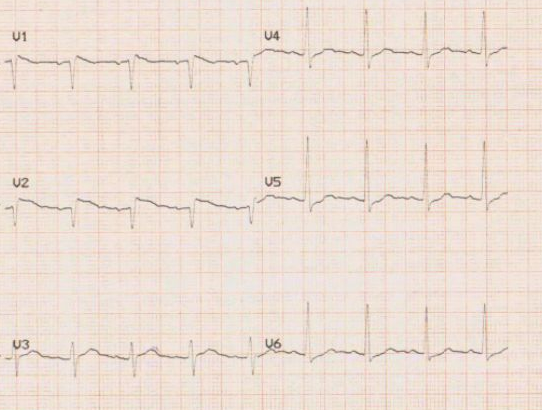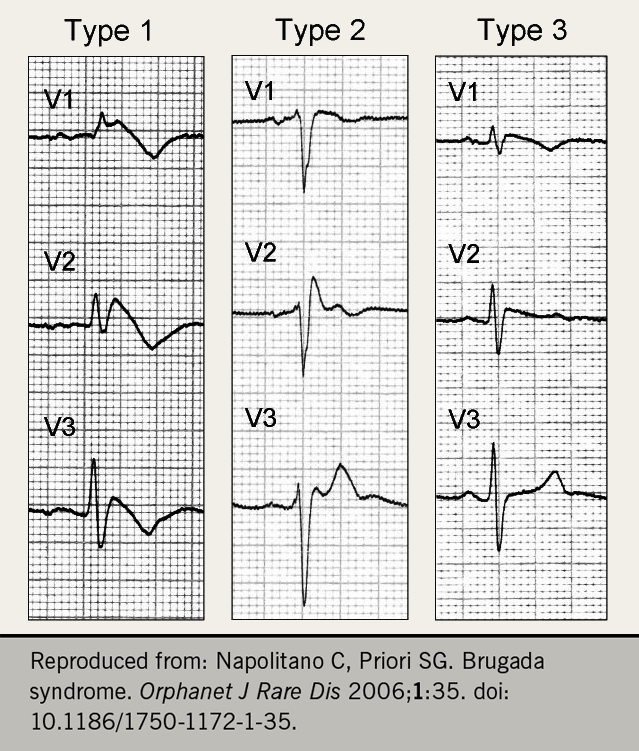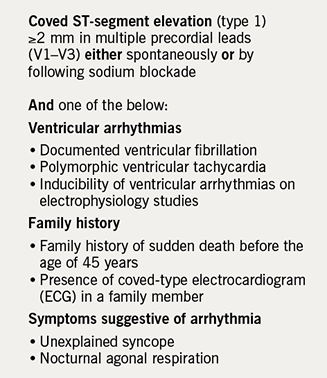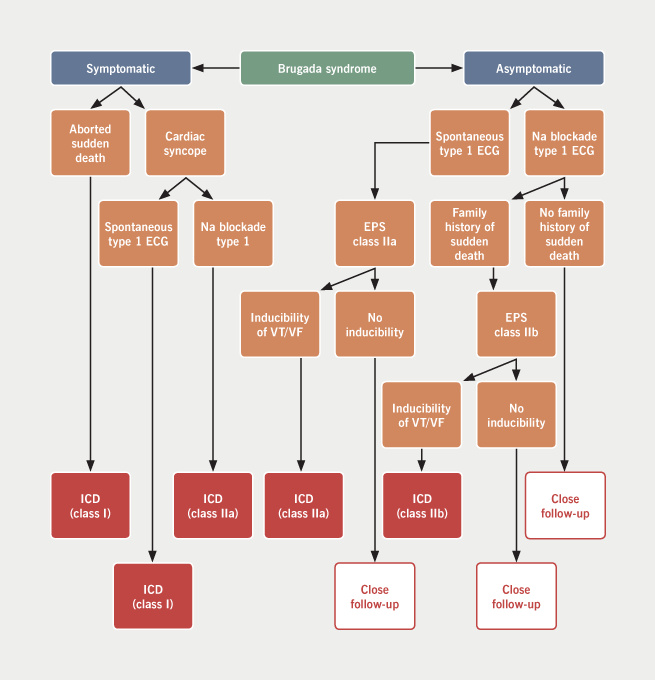Brugada syndrome is a distinct arrhythmogenic disorder widely recognised as a sudden cause of death in the young. It is identified by a classical ST-segment elevation on electrocardiogram (ECG) that may be provoked in the context of a fever or vagal stimulation. The pathophysiology and genetic basis have been elucidated as an abnormality in ion channels. Diagnosis takes into account, not only the ECG, but clinical features and modulating factors; the inducibility of a suspect ECG when febrile is one such observation. Anti-arrhythmic drugs like ajmaline can also induce Brugada syndrome and have a role in its work-up. Electrophysiology studies may be useful in assessment and risk stratification of select cases. The management is centred around device therapy with the implantable cardioverter defibrillator (ICD), though pharmacological treatments are being actively pursued.
Case
A 45-year-old woman with no significant past medical history presented to our hospital in October 2015 with coryzal symptoms. She complained of a sore throat, malaise and described a brief loss of consciousness. She was assessed and found to be febrile with a temperature of 38.3 degrees Celsius. Physical examination and work-up with blood tests and chest X-ray (CXR) were unremarkable. The working diagnosis was that of a flu-like illness. The patient was given reassurances and advised bed rest, fluids and paracetamol. She was discharged from hospital and it was not until her notes were reviewed by a consultant physician that a suspicion of Brugada syndrome arose.
Our patient had an electrocardiogram (ECG) as part of her assessment in the emergency department. The appearances of her ST segments in the chest leads evoked concern for a Brugada-like pattern (figure 1).

She was then recalled for an urgent assessment in the cardiology clinic. An echocardiogram was performed and did not reveal any structural abnormalities. The ejection fraction was >55%. Interestingly, a repeat ECG several days later showed partial resolution of the ST elevation. She was afebrile at the time of that review and denied a history of chest pain, palpitations or dizzy spells. There was no family history of arrhythmias or sudden unexplained death. We then referred this patient to our local tertiary cardiac centre for an electrophysiology opinion. There, further scrutiny into her history revealed two previous unexplained syncopal episodes. Without the need for electrophysiology studies, an implantable cardioverter defibrillator (ICD) was implanted in November 2015 with which she has been doing well.
Introduction
Brugada syndrome is an inherited sodium channelopathy of cardiac myocytes. It is a major cause of ventricular arrhythmias and sudden death in young people. The condition was first described in 1992. Being a relatively new clinical entity, the diagnostic criteria were substantiated just over a decade ago. Recognition of Brugada syndrome has seen an upward trend over recent years, as interest and awareness have grown. Prevalence is estimated at five in 10,000. However, this could be a considerable underestimate as many cases are never formally diagnosed. A typical example of this is the unexplained death of a young person in a third world country, for which no investigative measures are pursued in the form of autopsy or questioning of a familial link. Indigenous East Asian cultures have long recognised sudden unexplained death syndrome (SUDS) by various names: Pokkuri in Japan, Lai Tai in Thailand and Bangungot in the Philippines. This is a leading cause of death in young males in these parts of the world. The genetic and functional basis of these deaths may well be consistent with a Brugada syndrome.1
Genetics and pathophysiology
A fault in the sodium ion channel in the cell membranes of myocytes is the most commonly postulated pathophysiology. This accounts for approximately 20% of cases and results in a loss of the action potential dome in parts of the right ventricle. The theory is that uncontrolled epicardial and transmural dispersion of repolarisation ensues and predisposes to fatal arrhythmias. The gene identified in this process is SCN5A, located on the short arm of the third chromosome (3p21), and encodes a subunit of the cardiac sodium channel. Over a hundred different mutations in the SCN5A gene have been described.2 Loss of function results from a quantitive or qualitative dysfunction of the channels. Only 18% to 30% of patients with Brugada syndrome currently exhibit the relevant mutation.3 The consequences of a particular mutation on chromosomal function and expression of the disorder are still being understood, but it is clear that there is variable penetrance.4 Several other genes and their mutations have been discovered in association with Brugada syndrome and in ST elevation with a narrow QT interval.5 Some of these include CACNA1C and CACNB2, which effect calcium channels, and KCNE3, which alters normal potassium movement out of cells.
Inheritance is via an autosomal dominant pattern and the condition is most prevalent among Asian males.3 Although a familial link is often apparent, some cases can be sporadic.2 Interestingly, the incidence of the SCN5A mutation varies greatly among hereditary and sporadic cases of Brugada syndrome.4
Diagnosis
A clinical diagnosis of Brugada syndrome is often not straightforward. The suspicion can arise on presentation alone. A history of recurrent syncope with or without evidence for a significant arrhythmia in an otherwise young healthy individual should prompt concern. A family history of sudden unexplained death can also serve as a hint when eliciting a history. Electrocardiography and genetic testing are imperative in a formal diagnosis. Characteristic repolarisation patterns on ECG can be seen to suggest the possibility of Brugada syndrome. These changes may be found incidentally on a resting ECG, being present at all times. Conversely, such patterns may not always be apparent and only develop when a provoking anti-arrhythmic drug is administered. Three different ECG patterns have been described and are shown in the diagram below.6 The characteristic patterns are seen in contiguous right precordial lead (from V1 to V3) (figure 2).

- Type 1: coved ST elevation with at least 2 mm J-point elevation; the ST segment then descends gradually culminating in an inverted T-wave
- Type 2: minor ST elevation with a saddle-back appearance; the T-wave is positive or biphasic
- Type 3: similar to either type 1 (coved ST segment) or like type 2 (saddle-back ST segment) but with a less pronounced J-point elevation (<2 mm) and a lesser ST elevation (<1 mm)
It is important to remember that normal healthy people can also have the ECG appearances seen in a type-2 or type-3 Brugada ECG. It is only the type-1 ECG configuration that is deemed diagnostic as stated in the first consensus report of the Arrhythmia Working Group of the European Society of Cardiology.6 Drugs (class 1A, 1C and III anti-arrhythmics) can change the morphology of QRS complexes and ST segments in patients with suspected Brugada syndrome and thereby aid in a formal diagnosis. The ECG in these patients may also vary because of external factors, such as a fever. Vagal stimulation can also accentuate ST elevation. A case of Brugada syndrome is well documented in the case report of a man who died while shaving,1 as this presumably induced a fatal ventricular arrhythmia from carotid sinus massage.
Suspected cases are investigated with a challenge test with the anti-arrhythmic drugs ajmaline or flecainide. These are the two most commonly used drugs, however, others, including procainanide, pilsicainide, disopyramide and propafenone, have also been used.3 Ajmaline is a class 1A drug that acts by blocking sodium channels and subsequently causing the action potential to become longer. It may also disrupt potassium exiting cells. These effects ultimately extend the heart’s refractory period, meaning that it takes longer for myocytes to depolarise and repolarise.7 Bradycardia ensues as action potentials are prolonged and QT intervals are lengthened. Brugada syndrome already affects sodium channels and administration of ajmaline will result in a cumulative block. This is where typical ECG patterns (type-1) can manifest, not having been apparent initially. Ajmaline in a true Brugada patient can induce ventricular fibrillation. The challenge test should, therefore, always be done in a controlled environment with trained medical personnel and a defibrillator on standby. Continuous ECG monitoring is imperative and the test should be stopped immediately when:7
- A positive diagnosis has been made by the induction of a type-1 ECG pattern
- An arrhythmia develops or premature ventricular beats are seen
- QRS duration widens to exceed or equal 130% of the baseline
Flecainide is a class 1C anti-arrhythmic agent that induces prolongation of the action potential in myocytes by regulating the movement of sodium. It impairs myocardial contractility via a decelerating effect on electrical conduction. The ventricular myocardium and His-Purkinje system are primarily affected. Current data suggest that ajmaline is probably the best drug available in precipitating Brugada syndrome. Studies have shown it to have a superior sensitivity and specificity to flecainide.7
A definitive diagnosis is made when a type-1 ECG pattern is evident (in the presence or absence of a sodium-channel blocking agent) in conjunction with one of the following (table 1):3,6

- Documented history of ventricular fibrillation (VF) or polymorphic ventricular tachycardia.
- A family history of sudden death before the age of 45 years.
- The presence of a coved-type ECG in a family member
- Inducibility of ventricular arrhythmias with electrical stimulation
- A history of unexplained syncope
Clinical presentation and modulating factors
Undiagnosed Brugada syndrome can present with sudden death during sleep. The cause of sudden death is ventricular arrhythmia, specifically VF. If the arrhythmia associated with the underlying abnormal sodium channels is not sustained and fatal, patients present with syncope, dizziness and palpitations. Symptoms are a consequence of arrhythmias that appear without warning. Polymorphic ventricular tachycardia (VT) or VF have been described in 17% to 42% of diagnosed individuals.8,9 Supraventricular arrhythmias, like atrial fibrillation, can be seen in up to 20% of patients with Brugada syndrome.10 The correlation of an atrial pathology to an increased susceptibility for ventricular arrhythmias is the subject of further research and is still to be elucidated. Typically, symptoms and sudden death in Brugada patients occur at rest during the night. In one study, 26 of 30 VF episodes detected by ICDs in a cohort of patients were recorded during sleep. This is strongly suggestive of vagal activity predisposing to the arrhythmogenesis of Brugada syndrome.11
Sleep and increased vagal tone may be one modulating factor. It is important to remember that ECG patterns that represent the various appearances, as outlined earlier, can be fleeting in nature. Hormones and pharmacological agents are two other factors that are thought to alter transmembrane ionic currents.12,13 Pyrexia is also regarded as an important modulator in some patients with Brugada syndrome. Higher temperatures can accentuate early inactivation of sodium channels. Consequently, a febrile state (such as that seen in our patient) may unmask abnormal ECG morphology and raise suspicion.12 According to one study, febrile patients are 20 times more likely to develop an inherent type-1 Brugada ECG pattern than those who are afebrile.14 Fever has been identified as the trigger in about 18% of cardiac arrests in patients with symptomatic Brugada syndrome.1
Treatment: ICD and pharmacological approaches
Treatment for Brugada syndrome is essentially aimed at correcting potentially life-threatening ventricular arrhythmias as they occur. There is no way of preventing arrhythmias from occurring in the first place. The single most effective and proven treatment is the ICD. Patients are electrically shocked, i.e. cardioverted into a normal sinus rhythm as a life-saving measure. These devices are the mainstay of therapy and constantly monitor the heart rhythm. Symptomatic Brugada patients should always be offered an ICD. This recommendation was borne out of a consensus conference held in September 2003.4 Electrophysiology studies are useful in risk stratifying asymptomatic patients. An ICD should then be implanted where VF is inducible in the context of an incidental type-1 ECG. Alternatively, an ICD is appropriate where a sodium-channel blocker-induced ECG is precipitated in a subject who has a positive family history of sudden death. Those patients who have no family history and are symptom free but develop a type-1 ECG only after drug challenge should be kept under tight surveillance.4 The flowchart in figure 3 serves as a useful algorithm for management.

Given the cost implications of ICD therapy in under-privileged parts of the world, pharmacologic strategies are being sought. Quinidine and amiodarone are two such drugs being explored. This is also because ICDs can deliver inappropriate shocks in some individuals. In one study,15 at least 20% (45 out of 220) of patients experienced activation of the device and a shock incorrectly for reasons including sinus tachycardia, supra-ventricular arrhythmias, T-wave oversensing and lead malfunction.15,16
The objective of drugs is to steady the action potential by rebalancing the ion channel currents.17 In theory, this is achieved by either increasing inward positive currents or decreasing outward positive currents. The pharmacology of quinidine entails reduction of exiting currents. Initial studies suggested quinidine to be a reliable adjunctive treatment to the ICD in Brugada patients.18 It has been a much tested drug in patients who have had inducible ventricular arrhythmia during electrophysiology study (EPS). In one piece of work, quinidine successfully abolished inducible VF in 22 out of 25 patients. However, the drug was later withdrawn due to an adverse side effect profile.19
Beta blockers have proven clinical efficacy in the management of arrhythmias. They decrease dispersion of repolarisation throughout the myocardium via an increase in calcium currents (ICa).20 A role for beta blockers in controlling the electrical storm typical of Brugada syndrome is supported.21 Other drugs have been the subject of experimental work; one such being dimethyl lithospermate B, a derivative from a traditional Chinese herbal remedy that slows inactivation of sodium currents (INa) and subsequently impairs transmural and epicardial repolarisation. It has been postulated to terminate phase 2 re-entrant tachycardia leading to VT or VF.17 Phosphodiesterase III inhibitors like cilostazol are other pharmacological agents thought to be theoretically efficacious through a mechanism of increasing ICa. Results from case reports, however, have been variable.22,23 Amiodarone is another anti-arrhythmic drug, the use of which has been the subject of debate. It is predominantly a potassium ion channel blocker but may have sodium-blocking properties. Previously, it had been thought that amiodarone could uncover Brugada syndrome and predispose to ventricular arrhythmia by sodium-channel inhibition.24 However, there have been case reports where it has been used beneficially in suppressing VF. Its role in preventing triggered activity has been postulated by a mechanism whereby it prolongs action potential and increases refractoriness significantly. The theory is that, even if re-entry is initiated, the myocardium becomes too refractory to perpetuate it and, hence, an indirect suppression is induced.25
Epicardial ablation is a promising non-pharmacological option in Brugada syndrome. Although still in a preliminary phase, ablation of the right ventricular outflow tract (RVOT) has been shown to be effective for VF suppression and in the resolution of a type-1 ECG. This was evident in eight out of nine Brugada patients at a two-year follow-up according to one study.26 The selection of patients and the safety profile of ablation are currently being established. Complications including death have been quoted in the literature.27
Final thoughts
In our patient’s case, a flu-like illness and pyrexia unmasked a typical type-1 Brugada ECG, luckily without inducing a fatal arrhythmia. It is important to remember that palpitations and a serious rhythm disturbance are several-fold more likely in the presence of a fever. Therefore, timely and aggressive control of the fever is imperative.
The patient discussed does not seem to have had any clear evidence of an arrhythmia. She was completely asymptomatic when seen at our hospital prior to transfer to the tertiary centre. Interestingly, she did report a transient faint on initial presentation, which may have been overlooked. This could well have been syncope secondary to a malignant arrhythmia. Despite fulfilling the criteria of a supposed ‘Brugada ECG’, she did not immediately seem to have any one of the other requisite criteria. This is in part due to the complaint of ‘feeling faint’ being dismissed as anything significant and being attributed to coryza. The lesson to learn from this is that the history is key. Intensive enquiry to elicit any sort of loss of consciousness should always take place, and a collateral history sought after, if the patient has a poor recollection of the event themselves. There was no proof of a ventricular arrhythmia while the patient was in hospital on a cardiac monitor. A positive family history for sudden unexplained death at a young age was not apparent either. Hypothetically, if in this case a history of syncope had been comprehensively ruled out, the management may have been somewhat of a ‘watch and wait’ strategy. Equally, an EPS may have been pursued to look for an inducible arrhythmia. There is uncertainty surrounding the benefits of EPS in asymptomatic individuals who do not meet the diagnostic criteria. Nonetheless, deeper exploration into the history ultimately revealed incidence of multiple syncopes. This helped clinch the diagnosis of Brugada syndrome with the specialists convinced on the need for an ICD.
Individuals with a baseline abnormal (type-1 ECG), who are well, may be risk stratified by having an EPS to search for inducible VT/VF. A class II indication for an ICD is only then fulfilled, i.e. there is conflicting evidence about usefulness or efficacy. Performing an EPS in the first place in this cohort of patients is a contentious issue in itself; again a class II indication. An ICD should always be implanted where there is a proven ventricular arrhythmia in a symptomatic individual. Pertaining to our case, an EPS was not even considered once a cardiogenic syncope was suspected. An ICD was implanted almost straight away. Certainly, this was the safest course of action in view of the risks of inducing a potentially fatal arrhythmia in the absence of a device. A cardiac magnetic resonance imaging (MRI) was carried out to definitively rule out a structural cardiomyopathy prior to ICD implantation. Cardiac catheterisation could also have been offered to exclude coronary artery disease as a reason for ST elevation. Regardless, subsequent follow-up of this woman has been uneventful and she was doing well on her last review. Having two young children, she has been referred to a geneticist for familial screening of Brugada syndrome.
Brugada syndrome is a challenging clinical entity to diagnose, and equally so to manage. Research continues into the treatments, genetic background and confounding factors affecting the condition. Nonetheless, given the grave consequence of sudden unexpected death it is a topic around which much intrigue is drawn.
Key messages
- Brugada syndrome is an inherited sodium channelopathy of cardiac myocytes. It is a major cause of sudden death in young people who have structurally normal hearts
- Electrocardiography (ECG) is the investigation from which Bruagada patients are identified, though clinical features and modulating factors have a role to play. Flecainide and ajmaline are drugs used to precipitate characteristic ST elevation and right bundle branch block (RBBB)
- The implantable cardioverter-defibrillator is the single most effective and proven treatment in controlling life-threatening ventricular arrhythmias
- Fever is an important trigger and the onset of pyrexia (such as that seen in our patient) may unmask abnormal ECG morphology and raise suspicion of Brugada syndrome
Conflict of interest
None declared.
References
1. Vatta M, Dumaine R, Varghese G et al. Genetic and biophysical basis of sudden unexplained nocturnal death syndrome (SUNDS), a disease allelic to Brugada syndrome. Hum Mol Genet 2002;11:337–45. https://doi.org/10.1093/hmg/11.3.337
2. Schulze-Bahr E, Eckardt L, Paul M et al. Molecular genetics of the Brugada syndrome. In: Antzelevitch C, Brigade P (eds). The Brugada Syndrome: from Bench to Bedside. First edition. Blackwell Publishing, 2005;pp. 42–51. https://doi.org/10.1002/9780470994900.ch4
3. Benito B, Brugada R, Brugada J, Brugada P. Brugada syndrome. Prog Cardiovasc Dis 2008;51:1–22. https://doi.org/10.1016/j.pcad.2008.05.002
4. Schulze-Bahr E, Eckardt L, Breithardt G et al. Sodium channel gene (SCN5A) mutations in 44 index patients with Brugada syndrome: different incidences in familial and sporadic disease. Hum Mutat 2003;2:651–2. https://doi.org/10.1002/humu.9144
5. Antzelevitch C, Pollevick GD, Cordeiro JM et al. Loss-of-function mutations in the cardiac calcium channel underlie a new clinical entity characterized by ST-segment elevation, short QT intervals, and sudden cardiac death. Circulation 2007;115:442–9. https://doi.org/10.1161/CIRCULATIONAHA.106.668392
6. Wilde AAM, Antzelevitch C, Borggrefe M et al. Proposed diagnostic criteria for the Brugada syndrome. Eur Heart J 2002;23:1648–54. https://doi.org/10.1053/euhj.2002.3382
7. Wolpert C, Echternach C, Veltmann C et al. Intravenous drug challenge using flecainide and ajmaline in patients with Brugada syndrome. Heart Rhythm 2005;2:254–60. https://doi.org/10.1016/j.hrthm.2004.11.025
8. Brugada J, Brugada R, Antzelevitch C et al. Long-term follow-up of individuals with the electrocardiographic pattern of right bundle-branch block and ST-segment elevation in precordial leads V1 to V3. Circulation 2002;105:73–8. https://doi.org/10.1161/hc0102.101354
9. Priori SG, Napolitano C, Gasparini M et al. Natural history of Brugada syndrome: insights for risk stratification and management. Circulation 2002;105:1342–7. https://doi.org/10.1161/hc1102.105288
10. Eckardt L, Kirchhof P, Loh P et al. Brugada syndrome and supra ventricular tachyarrhythmias: a novel association? J Cardiovasc Electrophysiol 2001;12:680–5. https://doi.org/10.1046/j.1540-8167.2001.00680.x
11. Matsuo K, Kurita T, Inagaki M et al. The circadian pattern of the development of ventricular fibrillation in patients with Brugada syndrome. Eur Heart J 1999;20:465–70. https://doi.org/10.1053/euhj.1998.1332
12. Dumaine R, Towbin JA, Brugada P et al. Ionic mechanisms responsible for the electrocardiographic phenotype of the Brugada syndrome are temperature dependent. Circ Res 1999;85:803–09. https://doi.org/10.1161/01.RES.85.9.803
13. Amin AS, Meregalli PG, Bardai A, Wilde AA, Tan HL. Fever increases the risk for cardiac arrest in the Brugada syndrome. Ann Intern Med 2008;149:216–18. https://doi.org/10.7326/0003-4819-149-3-200808050-00020
14. Adler A, Topaz G, Heller K et al. Fever-induced Brugada pattern: how common is it and what does it mean? Heart Rhythm 2013;10:1375–82. https://doi.org/10.1016/j.hrthm.2013.07.030
15. Sacher F, Probst V, Iesaka Y et al. Outcome after implantation of a cardioverter-defibrillator in patients with Brugada syndrome: a multicenter study. Circulation 2006;114:2317–24. https://doi.org/10.1161/CIRCULATIONAHA.106.628537
16. Sarkozy A, Boussy T, Kourgiannides G et al. Long-term follow-up of primary prophylactic implantable cardioverter-defibrillator therapy in Brugada syndrome. Eur Heart J 2007;28:334–44. https://doi.org/10.1093/eurheartj/ehl450
17. Brugada P, Brugada R, Brugada J. Sudden death in patients and relatives with the syndrome of right bundle branch block, ST segment elevation in the precordial leads V1 to V3 and sudden death. Eur Heart J 2000;21:321–6. https://doi.org/10.1053/euhj.1999.1751
18. Hermida JS, Denjoy I, Clerc J et al. Hydroquinidine therapy in Brugada syndrome. J Am Coll Cardiol 2004;43:1853–60. https://doi.org/10.1016/j.jacc.2003.12.046
19. Belhassen B, Glick A, Viskin S. Efficacy of quinidine in high-risk patients with Brugada syndrome. Circulation 2004;110:1731–7. https://doi.org/10.1161/01.CIR.0000143159.30585.90
20. Yan GX, Antzelevitch C. Cellular basis for the Brugada syndrome and other mechanisms of arrhythmogenesis associated with ST-segment elevation. Circulation 1999;100:1660–6. https://doi.org/10.1161/01.CIR.100.15.1660
21. Ohgo T, Okamura H, Noda T et al. Acute and chronic management in patients with Brugada syndrome associated with electrical storm of ventricular fibrillation. Heart Rhythm 2007;4:695–700. https://doi.org/10.1016/j.hrthm.2007.02.014
22. Tsuchiya T, Ashikaga K, Honda T et al. Prevention of ventricular fibrillation by cilostazol, an oral phosphodiesterase inhibitor, in a patient with Brugada syndrome. J Cardiovasc Electrophysiol 2002;13:698–701. https://doi.org/10.1046/j.1540-8167.2002.00698.x
23. Abud A, Bagattin D, Goyeneche R et al. Failure of cilostazol in the prevention of ventricular fibrillation in a patient with Brugada syndrome. J Cardiovasc Electrophysiol 2006;17:210–12. https://doi.org/10.1111/j.1540-8167.2005.00290.x
24. D’Aloia A, Vizzardi E, Bugatti S et al. Brugada syndrome phenotype cardiac arrest in a young patient unmasked during the acute phase of amiodarone infusion: disclosure and aggravation of Brugada electrocardiographic pattern. J Electrocardiol 2012;45:411–13. https://doi.org/10.1016/j.jelectrocard.2012.02.005
25. Novak J, Lambiase PD. Treatment of electrical storm with amiodarone in Brugada syndrome: an unexpected protective effect. J Genet Syndr Gene Ther 2013;4:176. https://doi.org/10.4172/2157-7412.1000176
26. Nademanee K, Veerakul G, Chandanamattha P et al. Prevention of ventricular fibrillation episodes in Brugada syndrome by catheter ablation over the anterior right ventricular out flow tract epicardium. Circulation 2011;123:1270–9. https://doi.org/10.1161/CIRCULATIONAHA.110.972612
27. Schmidt B, Chun KR, Baensch D et al. Catheter ablation for ventricular tachycardia after failed endocardial ablation: epicardial substrate or inappropriate endocardial ablation? Heart Rhythm 2010;7:1746–52. https://doi.org/10.1016/j.hrthm.2010.08.010
